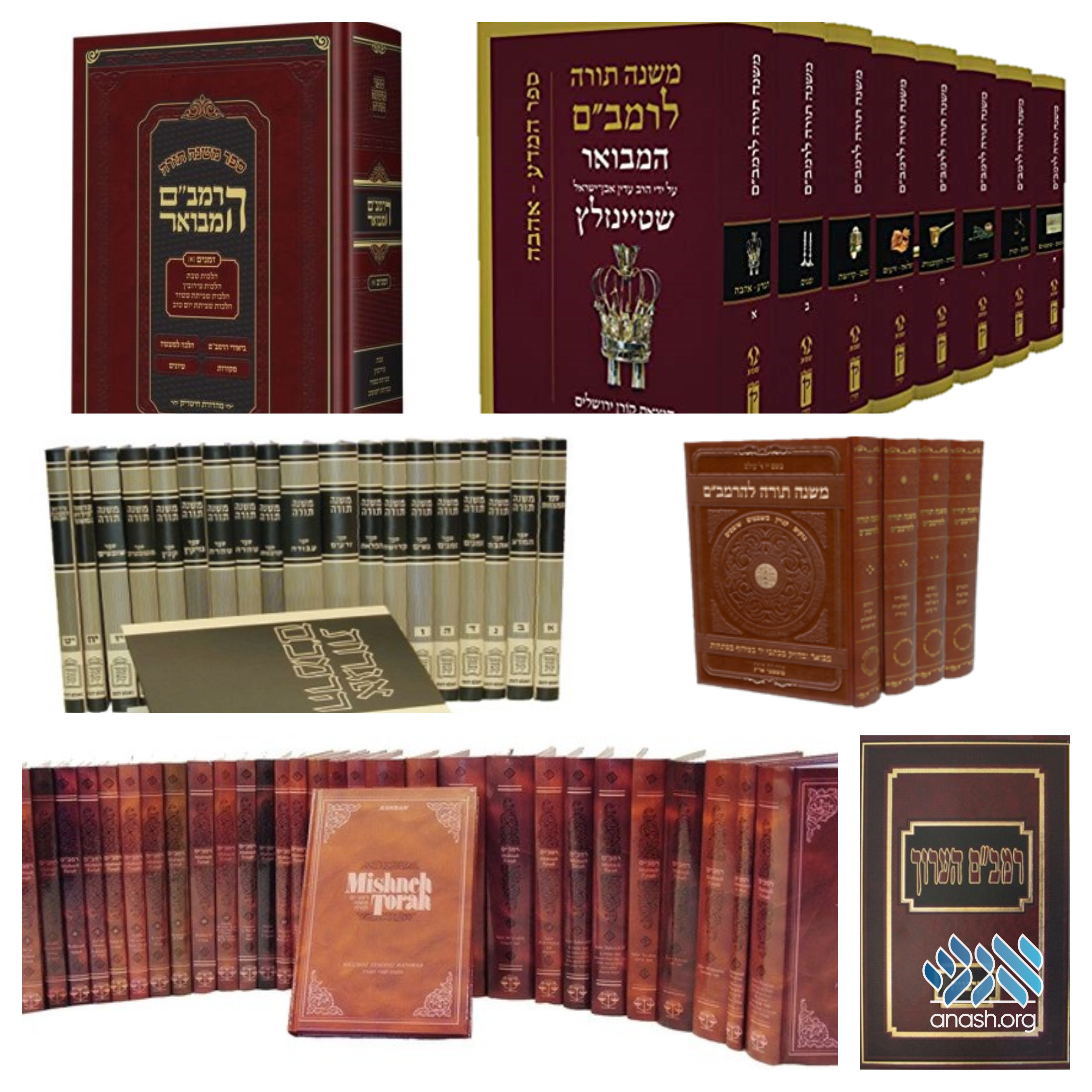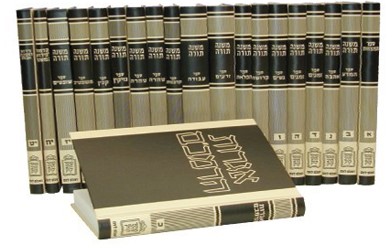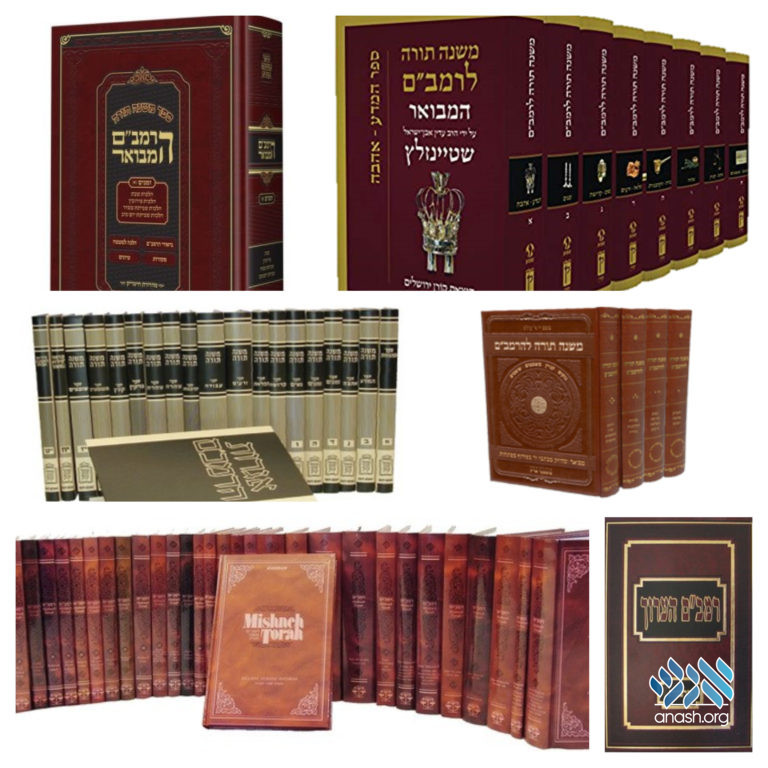ה׳ אב ה׳תשע״ט | August 6, 2019
Seforim Review: Rambam Sets
In honor of the start of the new Rambam cycle, we bring you a product review of contemporary Rambam commentaries.

By Rabbi Motti Wilhelm
The nine days between Rosh Chodesh Av and Tish’a B’av are generally known as a sad time, a time of mourning over the destruction of the Batei Mikdash. Yet this year, on the 4th of Av, thousands worldwide will be joining together to celebrate the completion of the 38th cycle of Rambam study. The completion of any sefer or masechta is a cause to rejoice. All the more so the completion of the entire Mishnah Torah, magnum opus of the Rambam, the only halacha sefer to cover all 613 mitzvos.
During the recent years, a blessed new phenomenon has been taking place. Seforim publishers, authors and organizations have been publishing sets of Rambam with explanations, each in their unique style, aiding veteran learners, and encouraging many to join this special study.
In honor of the Siyum Harambam here is a brief review, describing the advantages of each set, allowing an informed choice when purchasing a new Rambam, helping one find the style they enjoy.
Rambam L’am

The only set to precede the establishment of the daily Rambam study, Rambam L’am is arguably the most well-known. Published by Mossad Harav Kook, it has a similar style to the other Rishonim published by the same institution. When an explanation is brought, it is usually by discussing the background of the halacha from the Gemara, giving more than just the basic explanation in the words of the Rambam, and one comes out with a thorough understanding of the subject being discussed.
That being said, many of the footnotes are not explanations, but are rather references to the source of the halacha, leaving many halachos in Rambam unexplained. In addition, Rambam L’am does not usually explain ‘hard’ words, leaving many gaps in the explanation.
Mif’al Mishnah Torah
The stated goal of the Mifa’al Mishnah Torah organization is “the entire Torah, to everyone”, and indeed they did a superb job of making Rambam – which covers all the mitzvos of the Torah – accessible to a very wide audience.
The explanations are easy to understand, concise, and it includes charts, pictures, summaries and other such tools to make learning Rambam a pleasure. Also, each sefer includes a picture section, where one can see, in full color, the plants and tools mentioned in the Rambam and well as illustrations of the work in the Beis Hamikdosh, helping one to truly understand the sections in Rambam discussing agriculture (such as ספר זרעים), ancient tools (such as ספר טהרה), or the Beis Hamikdosh and Korbanos.
On the other hand, since the explanations are kept to the basic, they are not always thorough, and sometimes can leave one looking for a slightly deeper explanation.
In addition, the publishers have a very specific worldview, and it comes across strongly. To the best of their ability, they explain the Rambam solely based on Moreh Nevuchim. Wherever a disagreement between the Rambam and modern science, they will take the side of modern science. In general, they include at any possible opportunity the opinions of the Religious Zionists – “Mizrachi”.
Click here to purchase.
Steinzaltz Rambam
In response to the growing demand, another project was launched with a similar goal in mind.
Continuing in the footsteps of the famed Steinzaltz explanations on Shas, a team used the same methods to present the Rambam to the general public. Indeed, the Steinzaltz Rambam has unique qualities. On the bottom of each page the piskei dinim of the Rambam are compared to the Shulchan Aruch and contemporary poskim. Many enjoy being able to see the contrast and know the bottom line Halacha l’maaseh even when learning the daily Rambam. In addition, in the back of each of the 8 seforim, there are articles on selected subjects discussed in the Rambam, meant to give a full picture of the topic.
However, when it comes to the actual explanation, it would seem that the Mifa’al Mishnah Torah does a more complete job. While perhaps preferred by those used to the “Steinzaltz method,” the explanation does not utilize all the tools Mifa’al Mishnah Torah does, and uses others sparsely.
Click here to purchase.
Moznaim English Rambam
A great debt of gratitude is owed to Rabbi Eliyahu Touger and the Moznaim publishers, for bringing the Rambam to the many who wish to join the daily study, yet for whom English is their first language. Without a doubt, thousands have benefitted, and will continue to benefit from their monumental work.
However, even a good thing can always improve. The formatting in the printed books is not conducive to simultaneous Hebrew and English study. The footnotes, while helpful at times for understanding the Rambam, mainly consist of a mix of references, commentary and halacha. Whilst Chayenu has a more ready friendly format, we hope that in future editions of the printed set, they will incorporate more on-point explanations.
Click here to purchase.
***
Besides for the four sets mentioned above, there are other sets that are still in the process of being produced.
HaRambam Hamevuar
In the ‘seforim world,’ Artscroll is known for their high quality productions. Indeed, many are waiting for the day that Artscroll will produce their own Rambam. Until then, Harambam Hamevuar seems to be the closest there is, in quality and in style to Artscroll. The words of the Rambam are on the top of each page, followed by an explanation intertwined in the words of the Rambam. The explanation is thorough, but not unnecessarily long, and if one wants more depth, there are many footnotes quoting the classic commentaries and beyond.
On the bottom of the page, there is a הלכה למעשה section, bringing from the שו”ע, שו”ע אדה”ז and משנ”ב. It does not seem to bring from later poskim, or any other than the above three, obviously limiting the scope when compared to the Steinzaltz.
Towards the end of each volume are עיונים, which are short explanations, questions and answers, and similar commentary on the Rambam.
Click here to purchase.
Rambam Ha’aruch
There are those who are not satisfied with learning Rambam on the base level, but they are still looking for a commentary that does not require many hours of study. Rambam Ha’aruch is a great choice for them. It does not leave any question unanswered, and is not satisfied with merely grazing the surface, instead giving a depth not offered by the other sets.
Nevertheless, for the average learner the commentary might be confusing, not presenting a uniform method. When looking at a footnote, one does not know whether to expect a basic explanation, a vort from one of the meforshim, or a halacha from Alter Rebbe’s Shulchan Aruch. This style does not speak to those looking for more of a seamless learning experience.
Click here to purchase.
Rambam Hamevuar – Oz V’hadar
Oz V’hadar recently announced the launch of yet another project.
Following in a similar style to their well-known ‘Mesivta’ set on Shas, in which they published over 150 volumes, they will be producing a Rambam with a comprehensive explanation in no less than 48 volumes.
A welcome addition to any yeshiva or beis medrash library, the new seforim are a useful tool for reference or research. At the same time, its value for daily study of Rambam stands in question. The explanation on the Rambam’s words is wordy, requiring one to read lines of explanations for each sentence of Mishna Torah. Some may enjoy the “ילקוט ביאורים” section, where each halacha is discussed in depth, however with pages upon pages per perek, it does not seem to be geared for daily study of three or even one perek. To give an idea of the length, two full volumes are needed for one solitary set of halachos – Hilchos Mechira.
Click here to purchase.
***
Other resources:
Chazak Rambam
The classic all-in-one volume Rambam is generally viewed as a resource for shuls or yeshivos, precluding the need to purchase many sets of Rambam. Others who use it usually are those who do not have the need, or desire, for explanations.
It is nevertheless worthy to note, that the Chazak Rambam does include some simple explanations, mainly translations of harder words into Modern Hebrew. This is especially true of the new soft cover, 4 volume ‘ובלכתך בדרך’ edition. It is still far from being classified as a ביאור, yet it does deserve mention.
Click here to purchase.
Ezer V’siyua L’limud Harambam
Approximately four years ago, Vaad Talmidei Hatmimim started placing a large stress on the daily learning of Rambam, especially among yeshiva bochurim and campers in camps around the country. To that effect, they made booklets geared for the bochurim taking part.
The idea behind the booklets was phenomenal. Many American bochurim do not need the full translation offered by Moznaim, yet require selected words or phrases to be translated or explained. These booklets had the Rambam in middle, conveniently dividing the halachos into subjects and sub-subjects, with translations of hard words on the side, and basic explanation when needed on the bottom. One could safely assume that this project would quickly gain popularity among a wide range of Rambam learners who are native English speakers.
Unfortunately, the project did not endure, and they only published a booklet on part of Sefer Nashim, as well as a limited edition on all of Sefer Ahava.
***
As thousands worldwide celebrate the completion of the 38th cycle, and start of the 39th cycle of Limmud Harambam, we hope that these reviews help to find you the set that is your perfect match and will enhance your daily study.
Rabbi Motti Wilhelm can be reached at [email protected]


Mifal Mishna Torah is out of stock
Ezer vesiyua was made on:
last 30 perokim of shoftim.
Sefer Mada besides teshuva.
Sefer ahava.
Hilchos Ishus.
What a wonderful helpful article. I am so impressed. Yasher koach R’ Motti Wilhelm!
Very geshmak to read. Very informative. Thank so much for this thorough and comprehensive review.
Why post about a set that “Wherever a disagreement between the Rambam and modern science, they will take the side of modern science. In general, they include at any possible opportunity the opinions of the Religious Zionists – “Mizrachi”. ”
They are kofer betorah and you advice people to buy it????
Shame on you!!!
The most accepted opinion is that whatever the Rambam writes regarding health, is based on Chochmos Chitzoniyos. Therefore, since times have changed, you can “ignore” the opinion of the Rambam. That being said, that doesn’t mean that it’s not Torah, but that doesn’t mean that the writers are Kofrim.
Also, keep in mind that, this project was endorsed by Rabbi Ashkenazi Z”L – Rov of Kfar Chabad.
The Rabbi says in a sicha, that when someone learns the Rambam regarding health, he needs to say “Birchos hatorah” before, as it’s considered Torah. The reason why it’s not relevant, it’s because the world changed to not so pure as it was then.
The Rambam says good refuah is bloodletting; if you’re not a kofer yourself, then why not do it?